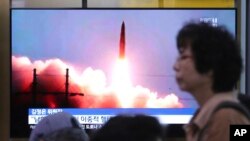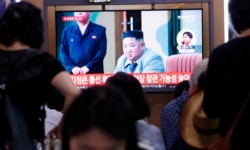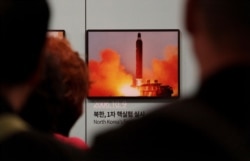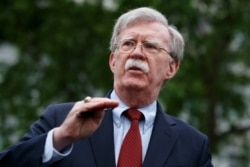Updated at 2:48 p.m. Aug. 1.
Lee Juhyun contributed to this report.
North Korea said Thursday its latest weapons test involved a new multiple rocket launch system — not ballistic missiles, as South Korea had reported — raising questions about whether the launch violated U.N. Security Council resolutions.
The official Korean Central News Agency (KCNA) said leader Kim Jong Un oversaw the test firing of a “newly developed large-caliber multiple launch guided rocket system” on Wednesday.
“After learning about the result of the test-fire, [Kim] said that it is very great and it would be an inescapable distress to the forces becoming a fat target of the weapon,” KCNA said in a report Thursday .
It is the latest in a series of North Korean weapons tests apparently aimed at increasing leverage over the United States and South Korea ahead of possible nuclear talks.
North Korea divulged very few details of the launch and released only a few pictures of the weapons, some of which were low quality or intentionally blurred.
But the North's version of the test seems to conflict with the assessment of South Korea's defense ministry, which had said the North fired "two short-range ballistic missiles" that traveled around 250 kilometers (155 miles) and reached an altitude of 30 kilometers (18.6 miles).
A U.S. official told VOA that despite Pyongyang's claims, the United States agreed with officials in Seoul, saying the test most likely involved KN-23 short-range ballistic missiles, a modified version of the Russian Iskander missile that North Korea has tested several times over the past three months.
The discrepancy between the North and South Korean accounts raised the possibility that Seoul is having problems tracking and identifying Pyongyang's new weapons. It could also be a matter of interpretation, since the line between ballistic missiles and rockets is blurry. Another option: North Korea could be mischaracterizing its tests, as it has done in the past.
Seoul sticks by its assessment
Responding to KCNA’s report, a spokesperson for South Korea’s defense ministry said U.S. and South Korean intelligence officials continued to assess that the weapon launched by the North shares “similarities with the new type of short-range ballistic missile” recently tested by the North. Asked to clarify, the spokesperson said the test was still being assessed.
Others in South Korea expressed skepticism about the North’s version of events.
“I believe it to be an SRBM [short-range ballistic missile],” Ahn Gyu-back, a South Korean ruling party lawmaker, told VOA.
The reason why North Korea called the weapon a rocket system, in Ahn’s opinion, is to avoid U.N. sanctions and international pressure.
"In fact, it is a ballistic [missile], which imitated the Iskander but is very crude," said Ahn, the chairman of the South Korean legislature’s National Defense Committee.
Rocket or missile?
It may be a distinction without much difference, since some rocket systems are so big they could qualify as missiles.
“The distinction between a 'ballistic missile' and 'rocket artillery' is somewhat artificial,” Ankit Panda, a senior fellow at the U.S.-based Federation of American Scientists, told VOA.
“The relevant difference is in how large the payloads can be and the military effectiveness,” Panda says. “You have regular artillery shells, which can be inaccurate because they’re unguided and small in their ordnance capacity. Multiple launch rocket systems are a step up: they can be guided and have slightly more boom to offer.”
But the definition does matter, since North Korea is banned from conducting any ballistic missile activity under U.N. Security Council resolutions. The council is set to discuss the matter in a closed-door meeting Friday, according to diplomats quoted in several reports.
“I think even though this is a multiple rocket launch system, it would constitute a violation of the relevant U.N. Security Council resolutions,” Panda says. “We’ll have to see what the U.N. Security Council does tomorrow.”
Moratorium on launches
Depending on how the latest test is characterized, North Korea has launched five or seven ballistic missiles since May.
U.S. and South Korean officials have shrugged off the launches, in an apparent attempt to preserve the possibility of nuclear talks with North Korea.
Speaking to Fox Business Network on Thursday, White House national security adviser John Bolton said the launches do not violate Kim’s pledge not to conduct intercontinental range ballistic missiles.
“But you have to ask when real diplomacy is going to begin, when the working-level discussions on denuclearization will begin,” Bolton said.
Kim in 2018 declared a self-imposed moratorium on intercontinental ballistic missile launches and nuclear tests. U.S. officials say Kim has also promised Trump not to conduct longer-range missile launches or nuclear tests.
Last month, North Korea’s foreign ministry threatened to resume ICBM and nuclear tests if Washington and Seoul went ahead with planned joint military exercises.
Short-range weapons still a threat
Though North Korean tests since May have involved only short-range weapons, they still represent a threat.
North Korea’s KN-23 short-range ballistic missile in particular appears to be built to avoid detection.
The missile is solid-fueled and launched from a truck, meaning it can be easily hidden and rapidly deployed. It flies quickly at low altitudes and is maneuverable in flight, making it easier for the missile to evade radar detection.
“It can be maneuvered during its ballistic trajectory, making it difficult to predict where the missile will land and intercept it before it does, and difficult to detect exactly where the missile came from,” says Duyeon Kim of the Center for a New American Security.
The emergence of the missile, and South Korea’s apparent difficulty in tracking it, has exposed possible gaps in South Korean and U.S. missile defense systems.
“I think the KN-23 is flying low enough that it is hard for South Korea’s radar to detect. It’s going to mean some expensive upgrades to track these new missiles better, or the U.S. will have to use space-based infrared and pass information very quickly to South Korea,” says Melissa Hanham, a weapons expert with the Open Nuclear Network.
“If we can’t track them, then we definitely can’t intercept them,” Hanham adds.
Trump’s reaction
Trump, who now appears to have established a precedent for not complaining about North Korea's short-range missile tests, is in an awkward position.
“Trump’s reactions to the missile tests have to walk that fine line between reacting too strongly and killing talks and not reacting at all, which could encourage Kim to keep testing in the future,” says Eric Gomez, a policy analyst focusing on missile defense systems at Washington’s Cato Institute.
“Trump has leaned more toward a light reaction to keep diplomacy alive,” he says. “This isn’t a bad approach, but he could also stand to be a bit tougher on North Korea rhetorically in order to try and get them to stop testing missiles.
"For example, Trump or another senior member of the administration could issue a strongly worded message criticizing the test while offering talks on security assurances that could include military drills as a topic, sending the message that there is a way for Kim to get what he wants but he can only do so via diplomacy and not missile tests," he adds.
Leif-Eric Easley, a professor at Ewha Womans University in Seoul, says it is inappropriate to shrug off the tests simply because they are short-range weapons.
"These missiles represent technological developments that threaten U.S. allies and forces in Asia," he says.













